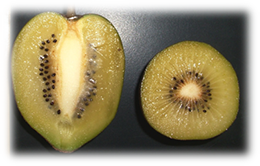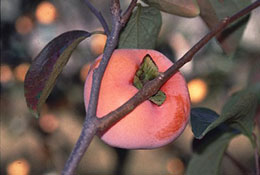TOKYO Brand Agricultural and livestock products
Introducing the TOKYO Brand agricultural and livestock products of which we take great pride in their taste and aroma.
Many of these products were developed and improved at the Tokyo Metropolitan Agriculture and Forestry Research Center which is part of the Tokyo Development Foundation for Agriculture, Forestry and Fisheries (Public Interest Incorporated Foundation).
- 1. The birth of Tokyo Gold, a new kiwi fruit grown in Tokyo (Agriculture)
- 2. Miyaka, a new cultivar of Udo that grows vigorously and has a high quality (Agriculture)
- 3. Tokyo Beni, an early ripening, beautifully colored sweet persimmon (Agriculture)
- 4. Sawayaka Midi, Odayaka, and Haruka Midi, cyclamen that have a wonderful aroma (Agriculture)
- 5. Tokyo Ukokei, a Silk fowl with improved egg laying rate (Livestock)
- 6. TOKYO X, a new brand of pig in Tokyo (Livestock)
- 7. Tokyo Shamo, a tastier chicken (Livestock)
1. The birth of Tokyo Gold, a new kiwi fruit grown in Tokyo

Tokyo Gold is a kiwi fruit cultivated by producers at the Tokyo Metropolitan Agriculture and Forestry Research Center and was registered with the Ministry of Agriculture, Forestry and Fisheries as a variety in July 2013.
Triggered by the registration of this cultivar, we aim for new brands of fruit trees in the Tokyo area and an increase in their production in the near future, while moving forward with initiatives that will have many of the Tokyo residents tasting these fruits.
Tokyo Gold characteristics
- The flesh is yellow and has a strong sweet taste while the core is pale yellow in color.
- The pulp is soft, with a strong sweet and moderately sour taste.
- Cutting the fruit along its length produces a heart shape.
2. Miyaka, a new cultivar of Udo that grows vigorously and has a high quality

Udo is a traditional brand of vegetable that represents Tokyo and was produced mainly in the Kitatama region from the Edo period. Currently, Tachikawa, Kokubunji, and Kodaira are the main production regions. Softening techniques, which produce a soft quality without losing the chewy texture, are at their highest level in Japan and are highly regarded by the market.
Miyaka, which was selected by the Tokyo Metropolitan Agricultural Experiment Station*, is a variety that is easy to cultivate, has thick roots, and is highly productive in terms of sprouting quantity. Softening substances provide it with a favorable appearance while turning it white and soft.
* Currently known as the Tokyo Metropolitan Agriculture and Forestry Research Center
3. Tokyo Beni, an early ripening, beautifully colored sweet persimmon

Varieties of sweet persimmons being shipped to market throughout Japan are mainly from Jiro or Fuyu. These varieties are also widely cultivated in Tokyo. However Tokyo Beni was created as a new unique cultivar to not compete with these existing varieties during harvest time.
The harvest time is towards the end of October, which is around ten days before the Jiro or Fuyu type appear, and can be harvested before these sweet persimmon fully reach stores in the Tokyo area, making them suitable for direct selling in Tokyo.
The fruit itself is large with a vivid orange color. It has a strong sweet flavor and a delicate high quality flesh. It was registered as a variety in 2005 and is currently being sold through direct sales stores.
4. Sawayaka Midi, Odayaka, and Haruka Midi, cyclamen that have a wonderful aroma

Cyclamen that represent Tokyo pot flowers are produced to the sum of approximately 270,000 pots per year in Tokyo, and give pleasure to all residents of the capital city.
At the Tokyo Metropolitan Agriculture and Forestry Research Center, it was highly appreciated for its wonderful fragrance, developed as a new type of cyclamen, and three varieties were registered by the year 2011.
Sawayaka Midi has light pink flowers and a sweet fragrance. Odayaka has bright reddish violet flowers and smells of green floral. Haruka Midi has pretty flowers with a pink lace-like fringe along the edge of the petals and gives off an enjoyable aroma of wood floral.
All three varieties are excellent in terms of growth compared to existing types of cyclamen, are hardy in the hot summer, and have compact roots. Furthermore, they continue to bloom from the beginning of autumn until winter so can be enjoyed for a great deal of time. Tokyo area producers sell these fragrant cyclamen directly from their cultivation houses.
5. Tokyo Ukokei, a Silk fowl with improved egg laying rate

It is said that Silk fowl were imported from China in the Edo period, and in addition to being bred as pets, their eggs and meat were used for Chinese herbal medicine.
However, these Silk fowl only lay around 50 to 80 eggs per year. At the Tokyo Metropolitan Livestock Experiment Station*, research proceeded for Tokyo Ukokei from 1991, so that the birds eventually were able to lay around 190 eggs per year.
* Currently known as the Tokyo Metropolitan Agriculture and Forestry Research Center
Due to recent research, it has become clear that transfer of Tokyo Ukokei that have stopped laying eggs allows them to be used as raw material for processed goods such as ham.
Tokyo Ukokei is raised in various regions throughout the Tokyo area and their eggs are sold mainly through direct sales.
6. TOKYO X, a new brand of pig in Tokyo

Tokyo Metropolitan Livestock Experiment Station* in 1997, it has tender meat marbled with fat and produces a juicy taste. In addition, scrupulous care is taken in the production system such as slowly rearing the pigs with feed and a breeding environment that considers increased safety. Since these pigs only give birth to a few number of piglets and they are quite sensitive in nature, they are best suited to small and medium sized pig farmers that can be meticulous in managing their breeding.
* Currently known as the Tokyo Metropolitan Agriculture and Forestry Research Center
Meat from TOKYO X is sold in department stores and small retailers in the Tokyo area under quality control based on agreements between producers and distributors. The meat is also synonymous with good tasting pork. The success of TOKYO X, whose brand creation has been promoted through cooperation with the government, producers and distributors, has gathered attention as a model for developing specialty products.
Currently, there are around 9,000 pigs per year in circulation.
7. Tokyo Shamo, a tastier chicken

In response to the many number of people who say "I don't just want a broiler, I want to eat some really good chicken", Tokyo Shamo was developed by the Tokyo Metropolitan Livestock Experiment Station*.
* Currently known as the Tokyo Metropolitan Agriculture and Forestry Research Center
Shamo or game fowl are famous as fighting birds. They have lots of muscle such as in the chest area, they taste good, and they have been used in many foods such as hot pot dishes since long ago. After removing the fighting nature of this game fowl, and cross-breeding it with other varieties, we have come up with the Tokyo Shamo.
Around 20,000 Tokyo Shamo, a particularly tasty chicken, have been produced in the Tokyo area, and are shipped to famous chicken restaurants in the city as well as other locations.




